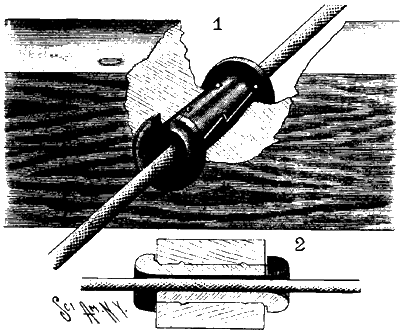[Trade Journal]
Publication: Scientific American
New York, NY, United States
p. 84, col. 2-3
A NEW INSULATOR.
The insulator which forms the subject of the accompanying engraving is constructed in the form of a tube, divided into longitudinal sections, each of which has interlocking shoulders and a head at its outer end, so that the sections may be fitted together to form a continuous tube, securely and effectively holding the conductor.
Of our illustrations, Fig. 1 is a perspective view and Fig. 2 is a sectional view, both showing the insulator in position.
The insulator is made in two duplicate sections, each having its edges provided with interlocking shoulders, as shown in Figs. 1 and 2. By this means the two sections can be made to fit exactly together. The head of each section is outwardly beveled to preven chafing of the wire, and is provided with a notch through which the wire may be passed. Projections on the sections are adapted to be embedded in the material and hold the insulator, to prevent the sections from turning and, therefore, displacing the insulator. As indicated in the engraving, the insulator is adapted to be held in the joist or other framing of a building through which the wire is to be passed.
By means of this device, the wires may be securely held and leakage prevented. The insulator may be applied after the wiring is done, or the insulator may be first placed in position and the wire then run through it. When once in place the insulator cannot be accidentally removed.
The device is the invention of Charles L. Wingard, Walla Walla, Washington.
 |
| Wingard's Insulator. |
